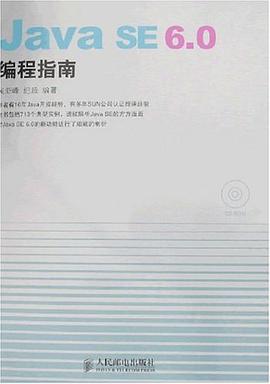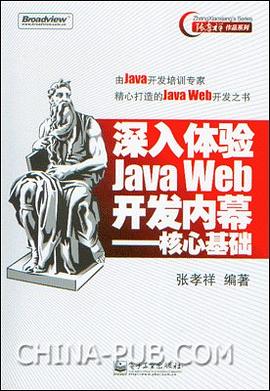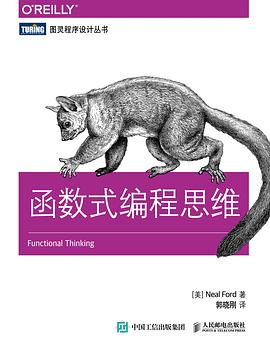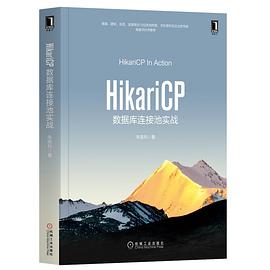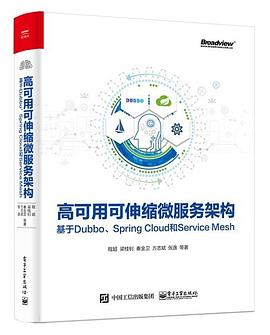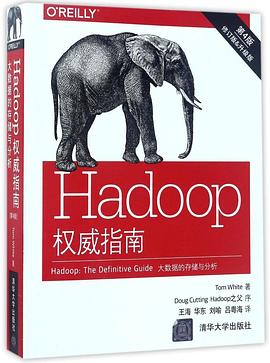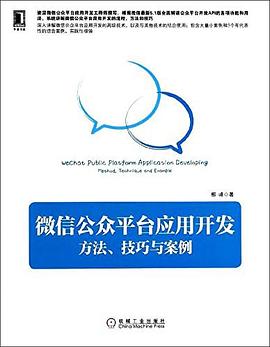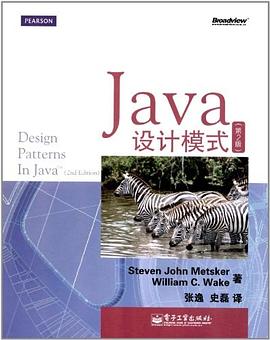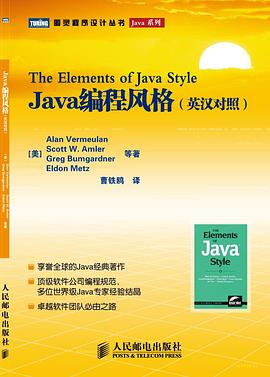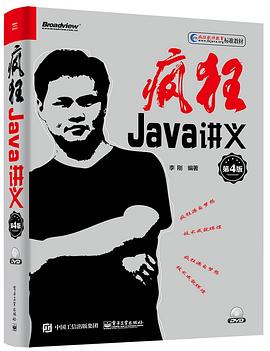

具體描述
Cay S.Horstmann等編著,公飛編譯的《Java核心技術》(Core Java)
自第1版齣版以來,一直備受廣大Java程序設計人員的青睞,暢銷不衰,是
Java經典書籍。第8版針對Java SE 6平颱進行瞭全麵更新,囊括瞭Java平
颱標準版(Java SE/J2SE)的全部基礎知識,提供瞭大量完整且具有實際意
義的應用實例,詳細介紹瞭Java語言基礎知識、麵嚮對象程序設計、接口
與內部類、事件監聽器模型、swing圖形用戶界麵程序設計、打包應用程序
、異常處理、登錄與調試、泛型程序設計、集閤框架、多綫程等內容。
本評注版力邀國內資深專傢執筆,在英文原著基礎上增加瞭點評和注
釋,並對原書內容進行瞭精簡,刪除瞭Java圖形窗口編程的相關內容,即
原書的第7-10章,同時對章節序號進行瞭相應的調整,從而使本書更集中
於Java核心語言。
本評注版的目的旨在以先行者的學研心得與實踐感悟,對讀者的閱讀
和學習加以點撥、指明捷徑。
《Java核心技術》中示例程序經過精心設計,不但具有實用價值,而
且易於閱讀理解,可以作為初學者自己編寫程序的良好開端,也能夠幫助
程序員快速地瞭解Java SE 6的新特性,或迅速從其他語言轉嚮Java語言。
著者簡介
CaycS.Horstmann是聖何塞州立大學計算機科學係教授、Java的倡導者.a他經常在計算機會議上講演.aCraycCornell已經教授程序設計專業課程20餘年,2並編寫多本專著.a他是Apress的創始人之一.a他撰寫的程序設計專業書籍十分暢銷,2是JoltcAward的最終獲奬者之一,2並在VisualcBasiccMagazin贏得瞭ReaderscChoice奬。
評注者簡介:
公飛 曾工作於中創軟件商用中間件有限公司、IBM全球信息科技服務部(GTS)和IBM全球業務谘詢服務部(GBS).a目前供職於山東魯能軟件技術有限公司,5負責該公司前瞻業務與技術研究、業務戰略管理、解決方案發展、産品與技術規劃、軟件架構管理、項目管理、軟件測試,5以及技術管理體係建設等方麵的工作。
圖書目錄
acknowledgements xxiv
chapter 1 an introduction to java(新增批注共25條) 1
java as a programming platform 2
the java “white paper” buzzwords 3
simple 3
object oriented 4
network-savvy 5
robust 5
secure 6
architecture neutral 7
portable 8
interpreted 9
high performance 9
multithreaded 10
dynamic 10
java applets and the internet 11
a short history of java 12
common misconceptions about java 15
.chapter 2 the java programming environment
(新增批注共20條) 21
installing the java development kit 22
downloading the jdk 22
setting the execution path 26
installing the library source and documentation 28
installing the core java program examples 28
navigating the java directories 29
choosing a development environment 32
using the command-line tools 33
troubleshooting hints 43
using an integrated development environment 45
locating compilation errors 49
running a graphical application 55
building and running applets 58
chapter 3 fundamental programming structures in java
(新增批注共44條) 63
a simple java program 64
comments 68
data types 70
integer types 70
floating-point types 71
the char type 72
the boolean type 74
variables 74
initializing variables 76
constants 76
operators 77
increment and decrement operators 78
relational and boolean operators 79
bitwise operators 81
mathematical functions and constants 81
conversions between numeric types 83
casts 84
parentheses and operator hierarchy 84
enumerated types 85
strings 86
substrings 86
concatenation 86
strings are immutable 87
testing strings for equality 88
code points and code units 89
the string api 90
reading the on-line api documentation 92
building strings 95
input and output 96
reading input 96
formatting output 98
file input and output 103
control flow 105
block scope 105
conditional statements 106
loops 109
determinate loops 113
multiple selections—the switch statement 117
statements that break control flow 119
big numbers 122
arrays 124
the “for each” loop 125
array initializers and anonymous arrays 126
array copying 126
command-line parameters 128
array sorting 129
multidimensional arrays 132
ragged arrays 135
chapter 4 objects and classes(新增批注共55條) 139
introduction to object-oriented programming 140
classes 142
objects 143
identifying classes 143
relationships between classes 144
using predefined classes 146
objects and object variables 146
the gregoriancalendar class of the java library 150
mutator and accessor methods 152
defining your own classes 158
an employee class 158
use of multiple source files 162
dissecting the employee class 163
first steps with constructors 164
implicit and explicit parameters 166
benefits of encapsulation 167
class-based access privileges 170
private methods 171
final instance fields 171
static fields and methods 172
static fields 172
static constants 173
static methods 174
factory methods 175
the main method 175
method parameters 178
object construction 185
overloading 185
default field initialization 185
default constructors 186
explicit field initialization 187
parameter names 188
calling another constructor 188
initialization blocks 189
object destruction and the finalize method 193
packages 194
class importation 195
static imports 196
addition of a class into a package 197
package scope 200
the class path 201
setting the class path 203
documentation comments 204
comment insertion 204
class comments 205
method comments 205
field comments 206
general comments 206
package and overview comments 207
comment extraction 207
class design hints 208
chapter 5 inheritance(新增批注共42條) 213
classes, superclasses, and subclasses 214
inheritance hierarchies 222
polymorphism 222
dynamic binding 224
preventing inheritance: final classes and methods 226
casting 227
abstract classes 229
protected access 234
object: the cosmic superclass 235
the equals method 236
equality testing and inheritance 238
the hashcode method 240
the tostring method 243
generic array lists 248
accessing array list elements 250
compatibility between typed and raw array lists 254
object wrappers and autoboxing 256
methods with a variable number of parameters 259
enumeration classes 260
reflection 263
the class class 263
a primer on catching exceptions 266
using reflection to analyze the capabilities of classes 268
using reflection to analyze objects at runtime 273
using reflection to write generic array code 277
method pointers! 281
design hints for inheritance 284
chapter 6 interfaces and inner classes(新增批注共24條) 289
interfaces 290
properties of interfaces 296
interfaces and abstract classes 297
object cloning 298
interfaces and callbacks 305
inner classes 307
use of an inner class to access object state 309
special syntax rules for inner classes 312
are inner classes useful? actually necessary? secure? 313
local inner classes 316
accessing final variables from outer methods 316
anonymous inner classes 319
static inner classes 322
proxies 325
properties of proxy classes 333
chapter 7 exceptions, logging, assertions, and debugging
(新增批注共38條) 335
dealing with errors 336
the classification of exceptions 338
declaring checked exceptions 340
how to throw an exception 342
creating exception classes 343
catching exceptions 344
catching multiple exceptions 346
rethrowing and chaining exceptions 348
the finally clause 349
analyzing stack trace elements 352
tips for using exceptions 357
using assertions 361
assertion enabling and disabling 361
using assertions for parameter checking 362
using assertions for documenting assumptions 363
logging 364
basic logging 364
advanced logging 365
changing the log manager configuration 367
localization 368
handlers 369
filters 373
formatters 373
a logging recipe 373
debugging tips 381
using a console window 387
tracing awt events 389
letting the awt robot do the work 393
using a debugger 396
chapter 8 generic programming(新增批注共22條) 401
why generic programming? 402
who wants to be a generic programmer? 403
definition of a simple generic class 404
generic methods 406
bounds for type variables 407
generic code and the virtual machine 409
translating generic expressions 411
translating generic methods 411
calling legacy code 413
restrictions and limitations 414
type parameters cannot be instantiated with primitive types 414
runtime type inquiry only works with raw types 415
you cannot throw or catch instances of a generic class 415
arrays of parameterized types are not legal 416
you cannot instantiate type variables 416
type variables are not valid in static contexts of generic classes 418
beware of clashes after erasure 418
inheritance rules for generic types 419
wildcard types 421
supertype bounds for wildcards 423
unbounded wildcards 424
wildcard capture 425
reflection and generics 430
using class[t] parameters for type matching 431
generic type information in the virtual machine 431
chapter 9 collections(新增批注共55條) 437
collection interfaces 438
separating collection interfaces and implementation 439
collection and iterator interfaces in the java library 441
concrete collections 447
linked lists 448
array lists 459
hash sets 459
tree sets 463
object comparison 464
queues and deques 469
priority queues 471
maps 472
specialized set and map classes 476
the collections framework 481
views and wrappers 487
bulk operations 493
converting between collections and arrays 494
algorithms 494
sorting and shuffling 496
binary search 498
simple algorithms 499
writing your own algorithms 500
legacy collections 502
the hashtable class 502
enumerations 502
property maps 503
stacks 504
bit sets 504
chapter 10 multithreading(新增批注共24條) 509
what are threads? 511
using threads to give other tasks a chance 517
interrupting threads 524
thread states 528
new threads 529
runnable threads 529
blocked and waiting threads 530
terminated threads 530
thread properties 531
thread priorities 531
daemon threads 533
handlers for uncaught exceptions 534
synchronization 535
an example of a race condition 536
the race condition explained 540
lock objects 541
condition objects 544
the synchronized keyword 549
synchronized blocks 553
the monitor concept 554
volatile fields 555
deadlocks 556
lock testing and timeouts 559
read/write locks 560
why the stop and suspend methods are deprecated 561
blocking queues 563
thread-safe collections 570
efficient maps, sets, and queues 570
copy on write arrays 572
older thread-safe collections 572
callables and futures 573
executors 577
thread pools 578
scheduled execution 582
controlling groups of tasks 583
synchronizers 584
semaphores 585
countdown latches 585
barriers 585
exchangers 586
synchronous queues 586
example: pausing and resuming an animation 586
threads and swing 592
running time-consuming tasks 594
using the swing worker 598
the single-thread rule 604
index 607
· · · · · · (收起)
讀後感
《java核心技术(卷1)》书评 最近花了一个多星期的时间看了《Java核心技术》卷一,感觉这本书是一本介绍java内容比较全面的一本书,几乎所有Java的知识点都有涉及,而且讲解的也很详细,对java的初学者来说是一本很好的入门书籍。该书对java中jdk的下载和安装部署都进行了详细的...
評分很基础,目前看到图形界面350页,适合初学者的一本java教材。前面的基础讲解的不错。后面的图形界面的有说明也有应用的实例,不知道后面的异常和多线程内容怎么样,看前面的部分来推测 应该不错。建议学Java的看看。
評分每次我的朋友来问我,学java看什么书好,我总是说:《Thinking in Java》是你一定要看的,但不是现在,那本书不适合入门。要入门,来,借这本书去吧,然后递给他这本《Core Java》(卷一)。 Java十年,发展如此迅速,J2EE之火热,令我大感惊讶,我为我几年前选择学Java刚到庆...
評分《Java核心技术卷一》是唯一可以和《[Java编程思想]》媲美的一本 Java 入门书。单从技术的角度来看,前者更好一些。但上升到思想层面嘛,自然后者更好,两者的偏重点不同。 思想不会变,所以《Java编程思想》还停留在第 4 版(2007 年);而技术是要更新迭代的,所以《Java核心...
評分用戶評價
僅有perl是不夠的,Let's look at the object, Java!!!
评分僅有perl是不夠的,Let's look at the object, Java!!!
评分有很多和 c++ 的比較,Collection 那章 寫的不錯。評注還行。
评分僅有perl是不夠的,Let's look at the object, Java!!!
评分僅有perl是不夠的,Let's look at the object, Java!!!
相關圖書
本站所有內容均為互聯網搜索引擎提供的公開搜索信息,本站不存儲任何數據與內容,任何內容與數據均與本站無關,如有需要請聯繫相關搜索引擎包括但不限於百度,google,bing,sogou 等
© 2025 book.quotespace.org All Rights Reserved. 小美書屋 版权所有



